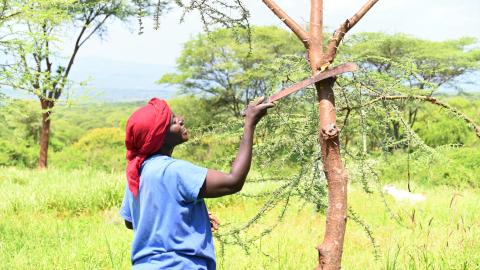
Central Rift Farmer Managed Natural Regeneration Scale-Up Project (CRIFSUP)
About: The Central Rift Farmer Managed Natural Regeneration Scale-Up Project (CRIFSUP) is a farmer-led World Vision initiative that aims to strengthen food security and livelihood resilience for smallholder farmers and pastoralists (women and men) in the arid and semi-arid lands of Kenya by 2026 through the Farmer Managed Natural Regeneration (FMNR) approach and other restoration techniques. The CRIFSUP project, now in Phase II, is funded by the Australian Department of Foreign Affairs and Trade (DFAT) through the Australian NGO Cooperation Program (ANCP).
Project Period: 1st July 2021 to 30th June 2026
Project Objectives
- Increase the area of land under restoration through FMNR
- Strengthen diversified livelihoods for smallholder farmers and pastoralists
- Enable an inclusive policy environment and structures that support the uptake of FMNR
Coverage Area
- Baringo County- Churo, Marigat, Mogotio
- Elgeyo Marakwet County- Soin, Ng’oswet, Tunyo
- Nakuru County- Salgaa
- West Pokot County- Chepareria
Farmer Managed Natural Regeneration (FMNR): This is a sustainable land restoration technique that depends on active management of bushlands, tree stumps and/or seeds that have self-germinated from the soil, allowing them to grow into productive trees.The FMNR approach provides a low-cost, low-risk method for large scale restoration of degraded landscapes while supplying farmers with valuable economic, social and environmental benefits.
Learn more about FMNR on https://fmnrhub.com.au/
The CRIFSUP Approach: It adopts a grassroots movement (down-up approach), creating a farmer-to-farmer spread at community level to ensure wide, sustainable uptake of the FMNR approach.The project works with lead farmers who are identified through local leadership structures at the community level. They are then trained on FMNR and mandated to reach out to at least 10 replicating farmers. This encourages enhancement of FMNR knowledge through peer learning and establishment of FMNR demonstration plots.
Project enabling models and components that complement the FMNR approach
The FMNR approach is integrated with other models and complementary components to address farmers’ needs and livelihood objectives. These include:
- Climate Smart Agriculture: This involves the promotion of conservation agriculture, soil and water erosion control interventions, forestry and agroforestry models, or sustainable agriculture models integrated in the project that maximises production on farms, diversifies diets for nutrition and increases income sources.
- Empowered World View: This is a development approach which seeks to interrogate the beliefs, practices, systems and structures of communities in light of their contribution and/ or hindrances to development (for a better future) as God intended. It leads to the transformation of the mind, heart and the pocket (economic empowerment).
- Local Value Chain Development (LVCD): This project model seeks to help people to generate more sustainable income that allows them to provide for the needs of their families and their children. Producers increase their wealth through better engagement with markets and by building relationships with critical service providers that can help them overcome market barriers. The broad objective of the Local Value Chain Development project model is to improve access to profitable markets for smallholder farmers and producers.
- Citizen Voice and Action (CVA): It provides the methodology and mechanisms for raising issues within the community and with the government. This is a simple, well-defined social accountability approach to community development. Social accountability approaches rely on mobilising and equipping citizens not only to understand their rights and hold government to account for its commitments and to bring about institutional change, but also to understand their responsibilities in bringing about this change.
- Savings for Transformation (S4T): This is a model that builds financial resilience by supporting community members to save together in a safe, convenient and flexible way. Savings groups are owned, managed and operated by the members, using a simple, transparent method whereby groups accumulate and convert small amounts of cash into savings.
- Sustainable and renewable energy options: Promotion of clean energy options in the community ensures controlled utilisation of energy sources e.g., charcoal use, firewood, biogas, use of solar instead of kerosene, etc.
